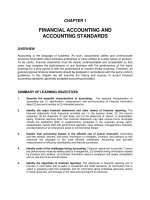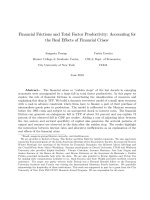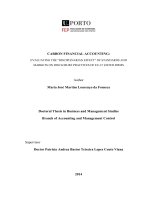Lecture Issues in financial accounting – Lecture 24: Accounting and the time value of money
Bạn đang xem bản rút gọn của tài liệu. Xem và tải ngay bản đầy đủ của tài liệu tại đây (1.19 MB, 53 trang )
PART II: Corporate Accounting Concepts and
Issues
Lecture 24
Accounting and the Time
Value of Money
1
Learning
Learning Objectives
Objectives
2
1.
Identify accounting topics where the time value of money is relevant.
2.
Distinguish between simple and compound interest.
3.
Use appropriate compound interest tables.
4.
Identify variables fundamental to solving interest problems.
5.
Solve future and present value of 1 problems.
Accounting
Accounting and
and the
the Time
Time Value
Value of
of Money
Money
Basic Time
Value
Concepts
Applications
The nature of
interest
Simple interest
Compound
interest
Fundamental
variables
3
Single-Sum
Problems
Future value
of a single
sum
Present value
of a single
sum
Solving for
other
unknowns
Basic
Basic Time
Time Value
Value Concepts
Concepts
Time Value of Money
A relationship between time and money.
A dollar received today is worth more than a dollar
promised at some time in the future.
4
LO 1 Identify accounting topics where the time value of money is relevant.
Basic
Basic Time
Time Value
Value Concepts
Concepts
Applications to Time Value Concepts:
1. Notes
2. Leases
3. Pensions and Other
Postretirement
Benefits
5. Shared-Based
Compensation
6. Business Combinations
7. Disclosures
8. Environmental Liabilities
4. Long-Term Assets
5
LO 1 Identify accounting topics where the time value of money is relevant.
Basic
Basic Time
Time Value
Value Concepts
Concepts
The Nature of Interest
6
Payment for the use of money.
Excess cash received or repaid over the amount
borrowed (principal).
LO 1 Identify accounting topics where the time value of money is relevant.
Basic
Basic Time
Time Value
Value Concepts
Concepts
Simple Interest
Interest computed on the principal only.
Illustration: Barstow Electric Inc. borrows $10,000 for 3 years
at a rate of 8% per year. Compute the total interest to be paid
for the 1 year.
Annual
Interest
Interest = p x i x n
= $10,000 x .08 x 1
= $800
Federal law requires the disclosure of interest rates on an annual basis.
7
LO 2 Distinguish between simple and compound interest.
Basic
Basic Time
Time Value
Value Concepts
Concepts
Simple Interest
Interest computed on the principal only.
Illustration: Barstow Electric Inc. borrows $10,000 for 3 years
at a rate of 8% per year. Compute the total interest to be paid
for the 3 years.
Total
Interest
Interest = p x i x n
= $10,000 x .08 x 3
= $2,400
Federal law requires the disclosure of interest rates on an annual basis.
8
LO 2 Distinguish between simple and compound interest.
Basic
Basic Time
Time Value
Value Concepts
Concepts
Simple Interest
Interest computed on the principal only.
Illustration: On October 1, 2012, Barstow Electric Inc. borrows
$10,000 for 3 months at a rate of 7% per year. Compute the
total interest to be paid for the year ended Dec. 31, 2012.
Interest = p x i x n
Partial
Year
9
= $10,000 x .08 x 3/12
= $200
LO 2 Distinguish between simple and compound interest.
Basic
Basic Time
Time Value
Value Concepts
Concepts
Compound Interest
10
Computes interest on
►
principal and
►
interest earned that has not been paid or
withdrawn.
Most business situations use compound interest.
LO 2 Distinguish between simple and compound interest.
Future
Future Value
Value of
of aa Single
Single Amount
Amount
The future value of a single amount is the amount of
money that a dollar will grow to at some point in
the future.
Assume we deposit $1,000 for three years that
earns 6% interest compounded annually.
$1,000.00 × 1.06 = $1,060.00
and
$1,060.00 × 1.06 = $1,123.60
and
11
$1,123.60 × 1.06 = $1,191.02
Future
Future Value
Value of
of aa Single
Single Amount
Amount
Writing in a more efficient way, we can say . . . .
$1,191.02 = $1,000 × [1.06]
3
Number
Number
of Compounding
of Compounding
FV = PV (1 + i)n
Periods
Periods
Future
Future
Value
Value
12
Amount
Amount
Invested at
Invested at
the Beginning
the Beginning
of the Period
of the Period
Interest
Interest
Rate
Rate
Future
Future Value
Value of
of aa Single
Single Amount
Amount
Using the Future Value of $1 Table, we find
the factor for 6% and 3 periods is 1.19102.
So, we can solve our problem like this. . .
FV = $1,000 × 1.19102
FV = $1,191.02
13
Present
Present Value
Value of
of aa Single
Single Amount
Amount
Instead of asking what is the future value of a
current amount, we might want to know what
amount we must invest today to accumulate a
known future amount.
This is a present value question.
Present value of a single amount is today’s
equivalent to a particular amount in the future.
14
Present
Present Value
Value of
of aa Single
Single Amount
Amount
Remember our equation?
FV = PV (1 + i)
n
We can solve for PV and get . . . .
PV =
15
FV
(1 + i)
n
Present
Present Value
Value of
of aa Single
Single Amount
Amount
Assume you plan to buy a new car in 5
years and you think it will cost $20,000 at
that time.
What amount must you invest today in order to
accumulate $20,000 in 5 years, if you can
earn 8% interest compounded annually?
16
Present
Present Value
Value of
of aa Single
Single Amount
Amount
i = .08, n = 5
Present Value Factor = .68058
$20,000 × .68058 = $13,611.60
Present Value
of $1 Table
17
If you deposit $13,611.60 now, at
8% annual interest, you will have
$20,000 at the end of 5 years.
Solving
Solving for
for Other
Other Values
Values
FV = PV (1 + i)n
Future
Future
Value
Value
Present
Present
Value
Value
Interest
Interest
Rate
Rate
Number
Number
of Compounding
of Compounding
Periods
Periods
There are four variables needed when
determining the time value of money.
18
If you know any three of these, the
fourth can be determined.
Determining
Determining the
the Unknown
Unknown
Interest
Interest Rate
Rate
Suppose a friend wants to borrow $1,000
today and promises to repay you $1,092 two
years from now. What is the annual interest
rate you would be agreeing to?
a. 3.5%
Present Value of $1 Table
b. 4.0%
$1,000 = $1,092 × ?
c. 4.5%
$1,000 ÷ $1,092 = .91575
d. 5.0%
Search the PV of $1 table
in row 2 (n=2) for this value.
19
Basic
Basic Time
Time Value
Value Concepts
Concepts
Illustration: Tomalczyk Company deposits $10,000 in the Last National
Bank, where it will earn simple interest of 9% per year. It deposits another
$10,000 in the First State Bank, where it will earn compound interest of 9%
per year compounded annually. In both cases, Tomalczyk will not
withdraw any interest until 3 years from the date of deposit.
Year 1 $10,000.00 x 9%
$ 900.00
$ 10,900.00
Year 2 $10,900.00 x 9%
$ 981.00
$ 11,881.00
Year 3 $11,881.00 x 9%
20
$1,069.29 $ 12,950.29
LO 2 Distinguish between simple and compound interest.
Basic
Basic Time
Time Value
Value Concepts
Concepts
Compound Interest Tables
Table 1 - Future Value of 1
Table 2 - Present Value of 1
Table 3 - Future Value of an Ordinary Annuity of 1
Table 4 - Present Value of an Ordinary Annuity of 1
Table 5 - Present Value of an Annuity Due of 1
Number of Periods = number of years x the number of
compounding periods per year.
Compounding Period Interest Rate = annual rate divided by the
number of compounding periods per year.
21
LO 3 Use appropriate compound interest tables.
Basic
Basic Time
Time Value
Value Concepts
Concepts
Compound Interest
How much principal plus interest a dollar accumulates to at the end of
each of five periods, at three different rates of compound interest.
22
LO 3 Use appropriate compound interest tables.
Basic
Basic Time
Time Value
Value Concepts
Concepts
Compound Interest
Formula to determine the future value factor (FVF) for 1:
Where:
FVF n,i
23
= future value factor for n periods at i interest
n
= number of periods
i
= rate of interest for a single period
LO 3 Use appropriate compound interest tables.
Basic
Basic Time
Time Value
Value Concepts
Concepts
Compound Interest
Determine the number of periods by multiplying the number
of years involved by the number of compounding periods
per year.
24
LO 3 Use appropriate compound interest tables.
Basic
Basic Time
Time Value
Value Concepts
Concepts
Compound Interest
9% annual interest compounded daily provides a 9.42%
yield.
Effective Yield for a $10,000 investment.
25
LO 3 Use appropriate compound interest tables.









